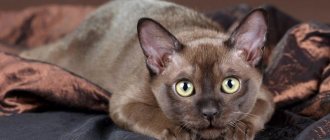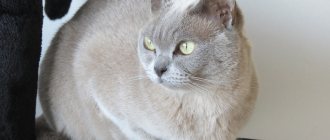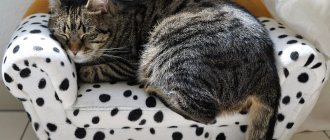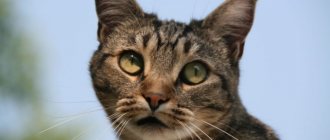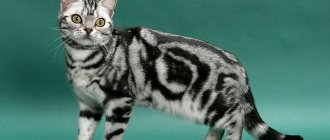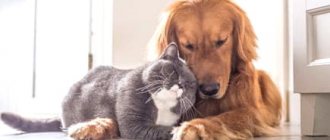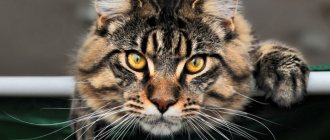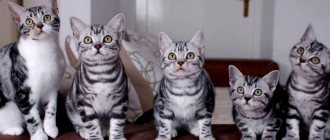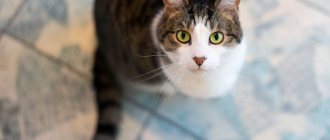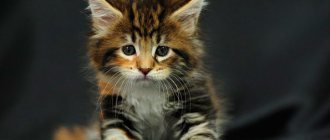The Burmese cat is recognized by many experts in felinology, and simply by cat lovers, as the most beautiful breed. Her grace, luxurious appearance, unusual eyes, reminiscent of precious stones, secured her the title of Miss Universe in the cat world.
Such an animal will decorate the house and will attract all the eyes of guests. It can be called a real work of art among the entire animal world. In addition to its expressive appearance, the cat has a wonderful character, tenderness and affection. Aggression, biting, and constant annoying meowing are not typical habits for a Burmese cat.
History of the breed
The country of Burma, also known as modern Myanmar, in addition to its picturesque natural landscapes typical of a tropical country, also has a breed of cat that first appeared here. The first description of the Burmese cat appeared in the 11th century. There are descriptions of them in works dating back to the 14th-15th centuries. Visual evidence of the existence of these animals are images of animals in paintings of that time.
The Burms were highly valued by the inhabitants of this ancient state, both ordinary citizens and local nobility and high officials. They could easily enter and move around temples, since religious leaders considered her close to their gods. The monks looked after them, fed them, and protected them. It was believed that this cat escorted the soul of its owner to heaven upon his death; it was also believed that they brought wealth, happiness, and prosperity to the house.
Burmese cat.
These cats first came to the Western world in the 19th century, and they were brought to Great Britain. Here they received a different name - black Siamese. Gradually the breed began to spread across continental Europe. The ancestors of the modern breed of Burmese cats that we know are mixed breeds of Siamese and Burmese. At the beginning of the 20th century, an American doctor who served in the navy acquired a kitten named Wong Mau. This owner's name is Joseph Thompson.
The kitten eventually became a reddish-brown color, with small dark markings. Thompson, admiring its beauty, began to look for like-minded people who would help him in breeding and popularizing these animals. Scientists from the University of California, as well as local felinologists, became his friends.
Interesting read: everything about the Balinese breed.
They later crossed their Wong with a Siamese cat named Tai Mau. The first litter had different colors. It contained seal point kittens, dark hazel. The decisive criterion for further breeding was the presence of chestnut color. The crossing of Wong and Tai gave rise to three colors:
- chocolate with dark tan;
- brown;
- sable
Thompson himself liked sable-colored specimens, and they became widespread. And in 1981, as a result of an accidental mating of a Burmese with a Persian cat, the Burmilla breed appeared. The silver Burmese, or Burmilla cat, got its name from two words (Burmese and chinchilla). Her luxurious coat color fully lives up to her name.
The Burmilla Shorthair is distinguished by its light bone structure, dense, plush-like coat and calm, kind disposition. The colors are solid, shaded, smoky, less often with patterns (tabby, tortie). Cat associations of felinologists were quickly recognized and allowed to participate in exhibitions: in 1989 by the GCCF, and in 1994 by the FIFe.
The Burmilla longhair was officially registered by the CSFF in 1989. In 1999, FA NSW attempted to reclassify the breed as the Australian Tiffany, but international organizations disagreed. Cats are distinguished by their semi-long, lush hair, dense constitution and developed muscles. The colors are shaded in a silvery range of shades.
Silver Burmese.
Burmilla shorthair.
Long-haired Burmilla.
Appearance of a Burmese cat
This is a small breed of cat. The cat's height is about 30 cm at the withers. The Burmese cat weighs 5-6 kg, the body weight of the female is 3-4 kg. Despite its average size, the animal has developed muscles.
The special pride of Burmese cats is their fur. It is very soft, reminiscent of velvet to the touch. It has the characteristic shine of this expensive fabric. The hairs lie tightly to the body. They have no undercoat completely. This has its pros and cons - the breed rarely causes allergies in humans, but the animal itself does not tolerate frost and air temperatures below 20 C.
The difference between the American Burmese and the European
The term Burmese itself is a general name that includes two separate breeds - the American and European Burmese cat. The main difference between these varieties is their appearance. The table below shows the main standards of the modern Burmese cat breed of American and European breeds:
As for colors, the breed has 4 main colors, which I then cross within the breed:
- sable;
- blue;
- champagne;
- platinum.
But later they noted that Burmese have other colors:
- blue;
- chocolate;
- tortoiseshell;
- cream;
- lilac;
- red;
- brown.
Individuals of European Burmese cats have genes for mixing these colors with each other. It can be chocolate tortoiseshell or blue tortoiseshell. These types are considered rare and are valued higher than other colors.
How did the European Burmese appear?
In 1949, three Burmese cats were brought to England. Local breeders immediately became interested in the animals and decided to follow the experience of American breeders. But, although Siamese cats were also used for mating, the result was different, because by that time purebred Siamese already had a different phenotype - a more refined skeleton, a different structure of the head and body. As a result, the European line of Burmese cats turned out to be in many ways different from the American one.
In 1952, felinological organizations in England approved standards for a new breed, which differed in many ways from the CFA standards. The large difference between the two breed branches was the reason for the separation of the European Burmese into a separate breed.
Colors of Burmese cats
The Burmese cat can have coat of almost any color. The most common colors are the following:
- Blue Burmese. Such individuals appeared in the 50s of the last century. The color may be uniform or have dark spots on the face, tail, and paws.
- Sable Burmese cat. The color of the coat is a rich chocolate color with transitions of dark shades to the muzzle and tail.
- Red Burmese. Rare color for this breed. The animal has a reddish tone to individual hairs, creating a pleasant reddish color. The eyes of such a cat should be amber-yellow. With a fleeting glance at your pet, it seems that it glows and shimmers with a gentle radiance. Yellow eyes make the pet even more “unearthly”.
- Champagne. The coat of these Burmese is a very light coffee-with-milk color. The paws, ears, and tail are painted in darker colors.
- Tortoiseshell. On the cat's body there are iridescences of different colors of fur. The spots have strict, clear outlines of different tones and shades.
- Lilac color. It is also called pearl grey. The color of the animal's coat varies in intensity, but the most popular is light gray with a slight admixture of pink.
A Burmese cat, no matter what color its coat is, should have darker paws, tail, nose, and back. Closer to the belly, the shade reduces its saturation and color intensity.
Burmese sable color.
Burmese lilac color.
Red Burmese cat.
Tortoiseshell Burmese kitten.
Blue Burmese cat.
Character and habits
The character of the Burmese cat is distinguished by its devotion to its owner, cheerfulness, but at the same time calmness and restraint.
Activity is one of the character traits of the breed, even in adulthood. She needs a large number of toys, free space for her games, and the attention of the owner. There is no need to hide her favorite toys; the cat will either find them or use other objects in this capacity. Many are sure that these animals have the soul and character of a dog. They spend a lot of time with their owner, giving him all their affection, tenderness, and devotion. Burmese can follow on the heels of its owner, and at night sleep at his feet, wrapped under a blanket. The character of the Burmese cat breed determines different attitudes towards owners - the pet loves all family members, but especially singles out only one, considering him the favorite and leader of his “pack”.
Interesting read: what size can a Maine Coon be?
Compatibility with other pets
Many people choose the Burmese cat because of its attitude towards other animals. She communicates with them kindly and affably. Usually they do not show aggression even towards their potential victims, who theoretically could become their dinner. Burmans get along well with other cats, especially if they have been close to each other since childhood. They get along well with other animals living in the same apartment or house.
If there are small pets in the house, such as parrots or hamsters, the likelihood that they will be eaten is minimal, but still possible.
How does a Burmese get along with children?
The Burmese cat gets along well with children. The child can play with it and spend their time together. Both parties receive a lot of joy and happiness from communication. A child who has had contact with a cat since childhood has a better attitude towards animals in the future. For him, the pet will become a real companion in his game.
How to choose a kitten
A Burmese kitten can be separated from its mother no earlier than three months from the moment of birth. During this period, the baby is ready for separation both physically and psychologically. When choosing a kitten from a nursery, you need to pay attention to its health. The kitten may have discharge from the eyes if they are clear in color. This is a regular tear fluid that cleanses the mucous membranes. You should be wary if it is yellow, in this case it is better to seek help from a veterinarian. Coat color develops before the first year. Sable color can be beige, with various shades of this color.
Purebred purebred animals can only be found in specialized nurseries. The bird market or ad sites are not the places where you can buy a real Burman. There is a high risk of acquiring a mestizo or a sick individual.
Kittens of the Burmese breed.
Who is the Burmese cat suitable for?
The Burmese breed is considered a versatile breed. Such pets take root well in all conditions if the family has children or other animals. Homebodies who will spend a lot of time with their pet can teach him simple tricks. You can walk with such a cat outside (just not during the frosty period). Allergy sufferers should not worry about animal hair; it does not provoke reactions.
If a person spends a lot of his time at work, it will be difficult for a cat, since they are considered sociable animals that need company and human attention. Being alone causes depression and stress.
How much does a Burmese cat cost?
You can buy a Burmese at a price from 15,000 to 35,000 rubles. The cost depends on the specific nursery, the pedigree of the animal, and its characteristics. If a kitten is purchased abroad, prices can vary from 30,000 to 50,000 rubles. Pet stores may offer lower prices, but it is more difficult to purchase a purebred purebred kitten here.
In the nursery you can choose ordinary Burmese or elite kittens. You can purchase disqualified kittens that have some flaws at a big discount. Individuals removed from breeding are also sold for a nominal fee.
Purchase: recommendations
Burmese kittens must be four months old at the time of purchase.
This way you can protect yourself as much as possible from purchasing a sick pet with genetic abnormalities, which will definitely manifest themselves at this age.
Burmese kittens
The kitten must have a color that meets the standard without white spots. The paws should be straight and strong, the eyes should be clear, the tail should not be kinked or damaged, and the belly should not be swollen.
The purchased animal must be active and easy to contact. You can try playing with it.
It is better to think in advance what gender and color you would like to get a pet. You should also immediately decide on the purpose of acquisition - for exhibition activities and breeding (show class) or just for yourself (pet class and below).
I recommend: Maine Coon; breed description
Where to buy, what to look for
Burmese are popular in Russia; many nurseries breed them. Basically, the sale of Burmese kittens is carried out by prior arrangement.
You should choose a nursery in advance. You can contact the club for recommendations on thematic forums.
On the page of the nursery’s website you can study the pedigrees of the parents, trace the offspring of the couple’s previous litters, and see how well they are exhibited.
Burmese are popular in Russia, many nurseries breed them
Burmese cat price
The price of purchasing a Burmese kitten depends on:
- titles and quality of ancestors' pedigrees;
- color,
- age of the animal;
- class;
- presence of deviations from breed standards;
- gender
The price of a show-class kitten is 80-100 thousand rubles in the Moscow experimental nursery from producers raised and purchased abroad.
Pet class kittens can be purchased for up to 40,000 rubles. Breeding class kittens can cost up to 25,000 rubles.
Education and training
Burmese are considered developed and intelligent animals. It is better to adapt a Burmese kitten to a new place of residence when it is over a month old. Accustoming to the litter box is also quick; the kitten understands everything that the owner wants from him after the first acquaintance with the litter box.
If the owner makes an effort and spends some time, the Burman can be taught simple commands - sit, lie down, voice, fetch. The main thing is to do it correctly, without violence, rudeness and aggression towards the animal. A patient attitude towards training your pet will definitely bear fruit, because this breed is distinguished by good intelligence.
Care and maintenance
Keeping a Burmese cat is not difficult. These are easy to care for animals that do not require any special conditions. It is important to properly care for its coat, especially for long-haired individuals. To ensure that the Burman's fur has a healthy shine, breeders advise periodically wiping it with a piece of silk. It is worth bathing a cat only in extreme cases, if it is very dirty or the animal is preparing for an exhibition - like most cats, the Burmese does not like water.
What to feed the Burmese
The Burmese cat is not picky about its diet. For good health and long life of your pet, you need to adhere to a healthy diet. The animal must receive all the necessary nutrients required for its body.
Natural nutrition should consist of 75% protein, the amount of fat should not exceed 10-12%. The basis is meat - veal, chicken, turkey. As a side dish - porridge, boiled or raw vegetables. Once a week you can give fish, preferably low-fat sea fish, a boiled chicken egg, and low-fat fermented milk products.
Material on the topic: how to feed Scottish cats.
As a ready-made food, you must choose premium or super-premium. If an animal needs to follow a diet for a number of health reasons, holistic food is chosen. The frequency of feeding depends on the age of the animal:
- up to 5 months – 4 times a day;
- 5-8 months – 3 times;
- adult animals – 2 times.
Poor nutrition can cause problems with the cardiovascular and genitourinary systems. Too frequent feeding causes obesity in your pet, and a number of diseases associated with this phenomenon. The following should be completely excluded from the animal’s diet:
- pickled products;
- any types of spices;
- raisins or grapes;
- bones;
- fat meat;
- beans;
- mushrooms.
It is better to choose filtered or bottled drinking water. Tap water may have high hardness, unwanted impurities, chlorine, and dangerous bacteria for the animal’s body.
Differences between modern and traditional American Burmese
Muzzle. The modern variety is more flattened, more reminiscent in appearance of the face of a British cat. In general, it does not look real, “toy-like”. It is shorter and wider, with a very pronounced transition from the forehead to the nose. It is represented by a thick strip of dark wool.
Eyes. Modern Burmese are large, wide, and convex. The slightly tapering and pointed corners are very clearly visible.
Ears. The modern variety has wider ones. They have more space between them.
Health and illness
The health and life expectancy of the Burmese cat depends mainly on proper nutrition. The average lifespan is 15-17 years. This breed is characterized by strong immunity and health. They are less likely to experience serious health problems or hereditary diseases or pathologies. But there are some problems that Burmans encounter:
- hard breath;
- lacrimation;
- deformed skull;
- inflammation of the gums;
- violation of the shape of the tail.
To maintain health, your pet must be shown to the veterinarian every six months, have all required vaccinations, and follow nutritional rules. The animal should receive regular medications against parasites (helminths). Preventive vaccination will not prevent specific diseases of Burmese cats, but will protect against other dangerous diseases.
Mating and breeding
The Burmese cat reaches sexual maturity quite quickly: estrus begins at 6-8 months. But they begin to breed Burmese cats a little later; it is necessary to wait until the pet reaches 1.5 - 2 years of age.
The mating rules for this breed require mating on the cat's territory: a gallant gentleman will actively court his beautiful lady for several days, giving her the most delicious food and giving her his own sleeping place.
After 2-3 days, the cat will be ready to mate: when crossed with each other, they produce healthy offspring; as a rule, there are 3-5 kittens in a litter. The pregnancy itself lasts 62-72 days. While expecting kittens, the expectant mother becomes more affectionate and phlegmatic. It is necessary to give her special vitamins to maintain strength; the veterinarian will tell you which ones specifically.
